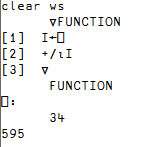APL
Dan Tobias (Talk | contribs) |
Dan Tobias (Talk | contribs) |
||
| (2 intermediate revisions by one user not shown) | |||
| Line 6: | Line 6: | ||
|caption=APL function | |caption=APL function | ||
}} | }} | ||
| − | |||
'''APL''', known best as "that programming language with all the weird symbols", was developed by Kenneth E. Iverson at IBM in 1960, based on a mathematical notation he had devised in 1957 and published in a book called ''A Programming Language'', from which the language's name came. | '''APL''', known best as "that programming language with all the weird symbols", was developed by Kenneth E. Iverson at IBM in 1960, based on a mathematical notation he had devised in 1957 and published in a book called ''A Programming Language'', from which the language's name came. | ||
| − | APL is capable of expressing complicated mathematical expressions such as various forms of matrix manipulation in a concise notation which makes use of a number of specialized symbols. Since these symbols were not part of the usual character sets (such as [[ASCII]] and [[EBCDIC]]) in use around the time the language was developed (though they have since been added to [[Unicode]] and can hence be expressed in modern character encodings such as [[UTF-8]]), a [[APL code page|specialized character set]] was used, often implemented as a separate type ball for IBM Selectric printing terminals. Special labels were often used on keyboards of terminals used for APL programming to show the characters the keys were associated with, which were different from the terminal's normal characters. Even in modern times, when the special characters are available as part of the Unicode set, actually typing them can be difficult without a specialized editor program designed for APL. | + | APL is capable of expressing complicated mathematical expressions such as various forms of matrix manipulation in a concise notation which makes use of a number of specialized symbols, many of them based on the Greek alphabet. Since these symbols were not part of the usual character sets (such as [[ASCII]] and [[EBCDIC]]) in use around the time the language was developed (though they have since been added to [[Unicode]] and can hence be expressed in modern character encodings such as [[UTF-8]]), a [[APL code page|specialized character set]] was used, often implemented as a separate type ball for IBM Selectric printing terminals. Special labels were often used on keyboards of terminals used for APL programming to show the characters the keys were associated with, which were different from the terminal's normal characters. Even in modern times, when the special characters are available as part of the Unicode set, actually typing them can be difficult without a specialized editor program designed for APL. |
== See also == | == See also == | ||
| Line 21: | Line 20: | ||
* [http://www.dmoz.org/Computers/Programming/Languages/APL/ Open Directory Project links on APL] | * [http://www.dmoz.org/Computers/Programming/Languages/APL/ Open Directory Project links on APL] | ||
* [http://www.quadibloc.com/comp/aplint.htm Remembering APL] | * [http://www.quadibloc.com/comp/aplint.htm Remembering APL] | ||
| + | * [http://www.computerhistory.org/atchm/the-apl-programming-language-source-code/ The APL Programming Language Source Code] | ||
[[Category:IBM]] | [[Category:IBM]] | ||
Latest revision as of 18:29, 2 January 2025
APL, known best as "that programming language with all the weird symbols", was developed by Kenneth E. Iverson at IBM in 1960, based on a mathematical notation he had devised in 1957 and published in a book called A Programming Language, from which the language's name came.
APL is capable of expressing complicated mathematical expressions such as various forms of matrix manipulation in a concise notation which makes use of a number of specialized symbols, many of them based on the Greek alphabet. Since these symbols were not part of the usual character sets (such as ASCII and EBCDIC) in use around the time the language was developed (though they have since been added to Unicode and can hence be expressed in modern character encodings such as UTF-8), a specialized character set was used, often implemented as a separate type ball for IBM Selectric printing terminals. Special labels were often used on keyboards of terminals used for APL programming to show the characters the keys were associated with, which were different from the terminal's normal characters. Even in modern times, when the special characters are available as part of the Unicode set, actually typing them can be difficult without a specialized editor program designed for APL.
